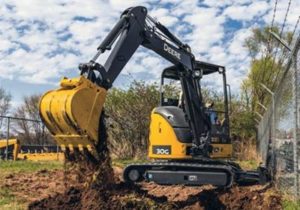 During the winter, ice and snow can sometimes create barriers for our crews to access water meters, fire hydrants or pipes underground.
During the winter, ice and snow can sometimes create barriers for our crews to access water meters, fire hydrants or pipes underground.
If there’s a water main break, or a pipe or valve that needs to be repaired, you may see our crews using heavy machinery to help them do their jobs.
The most familiar machine is a snowplow: a large truck with an oversized shovel attached that moves mounds of snow to clear streets and highways.
Here are other heavy machines you may see our crews using around town:
 |
A compact or mini-excavator is a tracked or wheeled vehicle with an approximate operating weight from 0.7 to 8.5 tons. It generally includes a standard backfill blade and features independent boom swing.Hydraulic excavators are somewhat different from other construction equipment in that all movement and functions of the machine are accomplished through the transfer of hydraulic fluid. The compact excavator’s work group and blade are activated by hydraulic fluid acting upon hydraulic cylinders. The excavator’s slew (rotation) and travel functions are also activated by hydraulic fluid powering hydraulic motors.
Excavators are also called diggers, mechanical shovels, or 360-degree excavators. Some uses for mini-excavators:
|
 |
A backhoe—also called rear actor or back actor—is a type of excavating equipment, or digger, consisting of a digging bucket on the end of a two-part articulated arm. It is typically mounted on the back of a tractor or front loader, the latter forming a “backhoe loader. The section of the arm closest to the vehicle is known as the boom, while the section that carries the bucket is known as the dipper (or dipper-stick), both terms derived from steam shovels. The boom is generally attached to the vehicle through a pivot known as the king-post, which allows the arm to pivot left and right, usually through a total of 180 to 200 degrees.The term “backhoe” refers to the action of the bucket, not its location on the vehicle. That is, a backhoe digs by drawing earth backwards, rather than lifting it with a forward motion like a person shovelling, a steam shovel, or a bulldozer. The buckets on some backhoes may be reconfigured facing forward, making them “hoes”.
Some uses for a backhoe:
|
 |
A skid loader, skid-steer loader or skidsteer is a small, rigid-frame, engine-powered machine with lift arms that can attach to a wide variety of labor-saving tools or attachments.Skid-steer loaders are typically four-wheeled or tracked vehicles with the wheels mechanically locked in synchronization on each side, and where the left-side drive wheels can be driven independently of the right-side drive wheels. The wheels typically have no separate steering mechanism and hold a fixed straight alignment on the body of the machine. Turning is accomplished by differential steering, in which the left and right wheel pairs are operated at different speeds, and the machine turns by skidding or dragging its fixed-orientation wheels across the ground.
Some uses for a skid loader:
|
 |
A snowplow is a device intended for mounting on a vehicle, used for removing snow and ice from outdoor surfaces, typically those serving transportation purposes. Although this term is often used to refer to vehicles mounting such devices, more accurately they are known as winter service vehicles, especially in areas that regularly receive large amounts of snow every year, or in specific environments such as airfields.Some uses for a snowplow:
|

